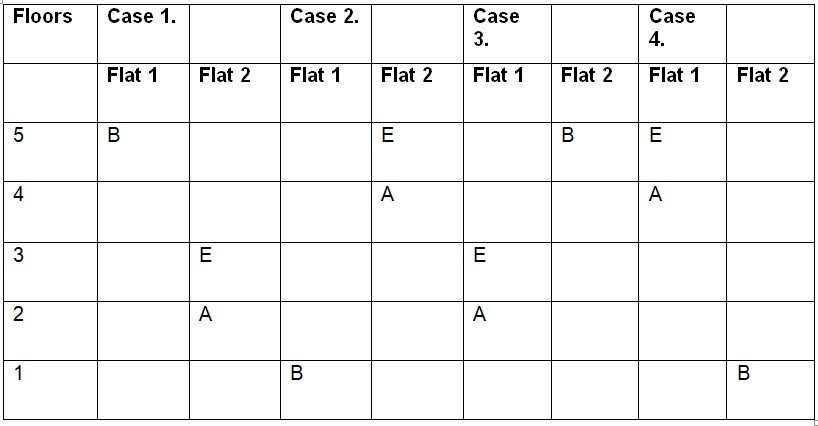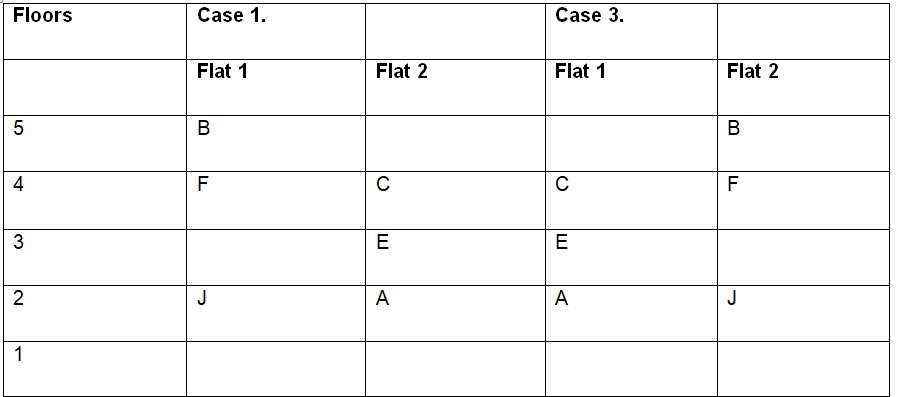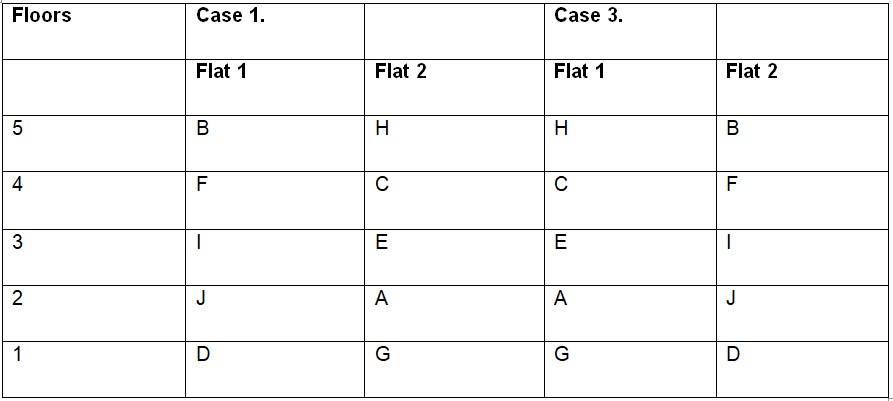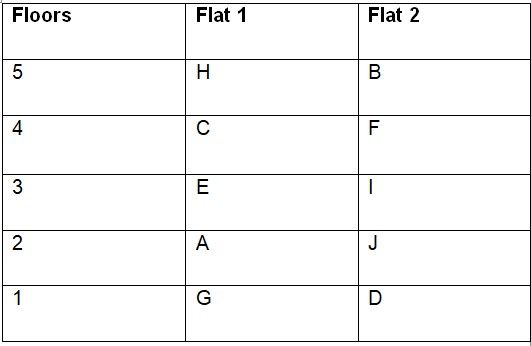Question
Who among the following lives with B in the same
floor? Study the following information carefully to answer the given questions: Ten persons A, B, C, D, E, F, G, H, I and J are living in a five storey building such that ground floor is numbered as 1, above it is floor 2 then top floor is numbered as 5. Each of the floor has 2 flats in it as flat-1 and flat-2. Flat-1 of floor-2 is immediately above flat-1 of floor-1 and immediately below flat-1 of floor-3 and so on. In the same way flat-2 of floor-2 is immediately above flat-2 of floor-1 and immediately below flat-2 of floor-3 and so on. Flat-1 is in west of flat-2. B lives in an odd numbered floor. Both E and G lives in the same flat number. C and F live in the same floor. H does not live in flat number 2. There is a gap of two floors in which B and A lives. Both A and B do not live in the same flat number. E lives immediately above A in the same flat number. There is a gap of one floor in which E and G lives. J, who lives on an even numbered floor, lives below F and both lives in the same flat number. I lives above D and both live in the same flat number. H and D neither live in the same flat number nor in the same floor.Solution
B lives in an odd numbered floor. There is a gap of two floors in which B and A lives. Both A and B do not live in the same flat number. E lives immediately above A in the same flat number. From these statements we will have four cases: If B lives on fifth floor in flat 1, then A lives on second floor in flat 2. As E lives immediately above A in the same flat number. So, E will live on third floor in flat 2. If B lives on first floor in flat 1, then A lives on fourth floor in flat 2. As E lives immediately above A in the same flat number. So, E will live on fifth floor in flat 2. If B lives on fifth floor in flat 2, then A lives on second floor in flat 1. As E lives immediately above A in the same flat number. So, E will live on third floor in flat 1. If B lives on first floor in flat 2, then A lives on fourth floor in flat 1. As E lives immediately above A in the same flat number. So, E will live on fifth floor in flat 1.  Both E and G lives in the same flat number.C and F live in the same floor. (vi) J, who lives on an even numbered floor, lives below F and both lives in the same flat number. From these statements Case 2 and Case 4 will get discarded as G lives on third floor. C and F live on same floor and J lives below F in even number floor which can’t be possible. So, we will proceed with Case 1 and Case 3. Case 1. F cannot live on fourth floor in flat 2 as J lives below F in even number floor. So, F and C will live on fourth floor in flat 1 and flat 2 respectively. Then J lives on second floor in flat 1. Case 3. F cannot live on fourth floor in flat 1 as J lives below F in even number floor. So, F and C will live on fourth floor in flat 2 and flat 1 respectively. Then J lives on second floor in flat 2.
Both E and G lives in the same flat number.C and F live in the same floor. (vi) J, who lives on an even numbered floor, lives below F and both lives in the same flat number. From these statements Case 2 and Case 4 will get discarded as G lives on third floor. C and F live on same floor and J lives below F in even number floor which can’t be possible. So, we will proceed with Case 1 and Case 3. Case 1. F cannot live on fourth floor in flat 2 as J lives below F in even number floor. So, F and C will live on fourth floor in flat 1 and flat 2 respectively. Then J lives on second floor in flat 1. Case 3. F cannot live on fourth floor in flat 1 as J lives below F in even number floor. So, F and C will live on fourth floor in flat 2 and flat 1 respectively. Then J lives on second floor in flat 2.  H does not live in flat number 2.There is a gap of one floor in which E and G lives. I lives above D and both live in the same flat number. H and D neither live in the same flat number nor in the same floor. Case 1. I and D cannot live in flat 2 as there is a gap of one floor in which E and G lives. So, I and D will live on third floor and first floor in flat 1. H and D neither live in the same flat number nor in the same floor. H cannot live on first floor with D. So, H live son fifth floor in flat 2 but this case will get discarded as it is given that H does not live in flat number 2. Case 3. I and D cannot live in flat 1 as there is a gap of one floor in which E and G lives. So, I and D will live on third floor and first floor in flat 2. H and D neither live in the same flat number nor in the same floor. H cannot live on first floor with D. So, H live son fifth floor in flat 1 and G lives on first floor in flat 1.
H does not live in flat number 2.There is a gap of one floor in which E and G lives. I lives above D and both live in the same flat number. H and D neither live in the same flat number nor in the same floor. Case 1. I and D cannot live in flat 2 as there is a gap of one floor in which E and G lives. So, I and D will live on third floor and first floor in flat 1. H and D neither live in the same flat number nor in the same floor. H cannot live on first floor with D. So, H live son fifth floor in flat 2 but this case will get discarded as it is given that H does not live in flat number 2. Case 3. I and D cannot live in flat 1 as there is a gap of one floor in which E and G lives. So, I and D will live on third floor and first floor in flat 2. H and D neither live in the same flat number nor in the same floor. H cannot live on first floor with D. So, H live son fifth floor in flat 1 and G lives on first floor in flat 1.  Final arrangement as shown below:
Final arrangement as shown below: 
Common Subexpression Elimination (CSE) is an optimization technique that:
Which memory allocation strategy is used for global variables and static variables, where memory is allocated once at compile time and remains throughou...
What is the purpose of Normalization in database design?
A 3-address instruction typically has the form:
Which data structure is commonly used in implementing a recursive descent parser?
Which of the following parsers is the most powerful (can parse the largest class of grammars)?
In a compiler, lexical analysis is responsible for:
"Liveness analysis" in code optimization determines:
Which of the following is the first phase of a compiler?
Which of the following algorithms is specifically designed to minimize the average time a process spends waiting before execution in a CPU scheduling co...
Relevant for Exams:


